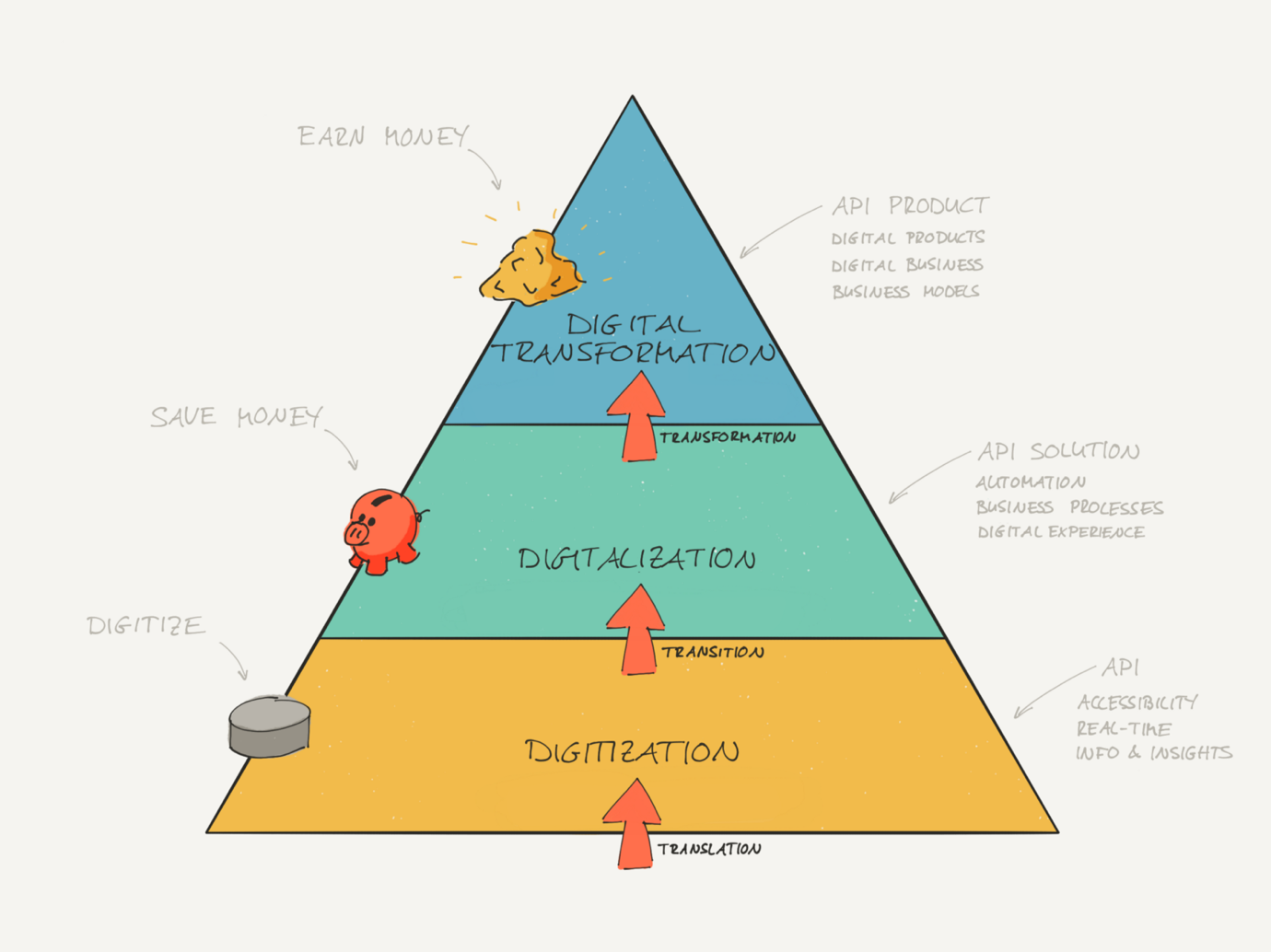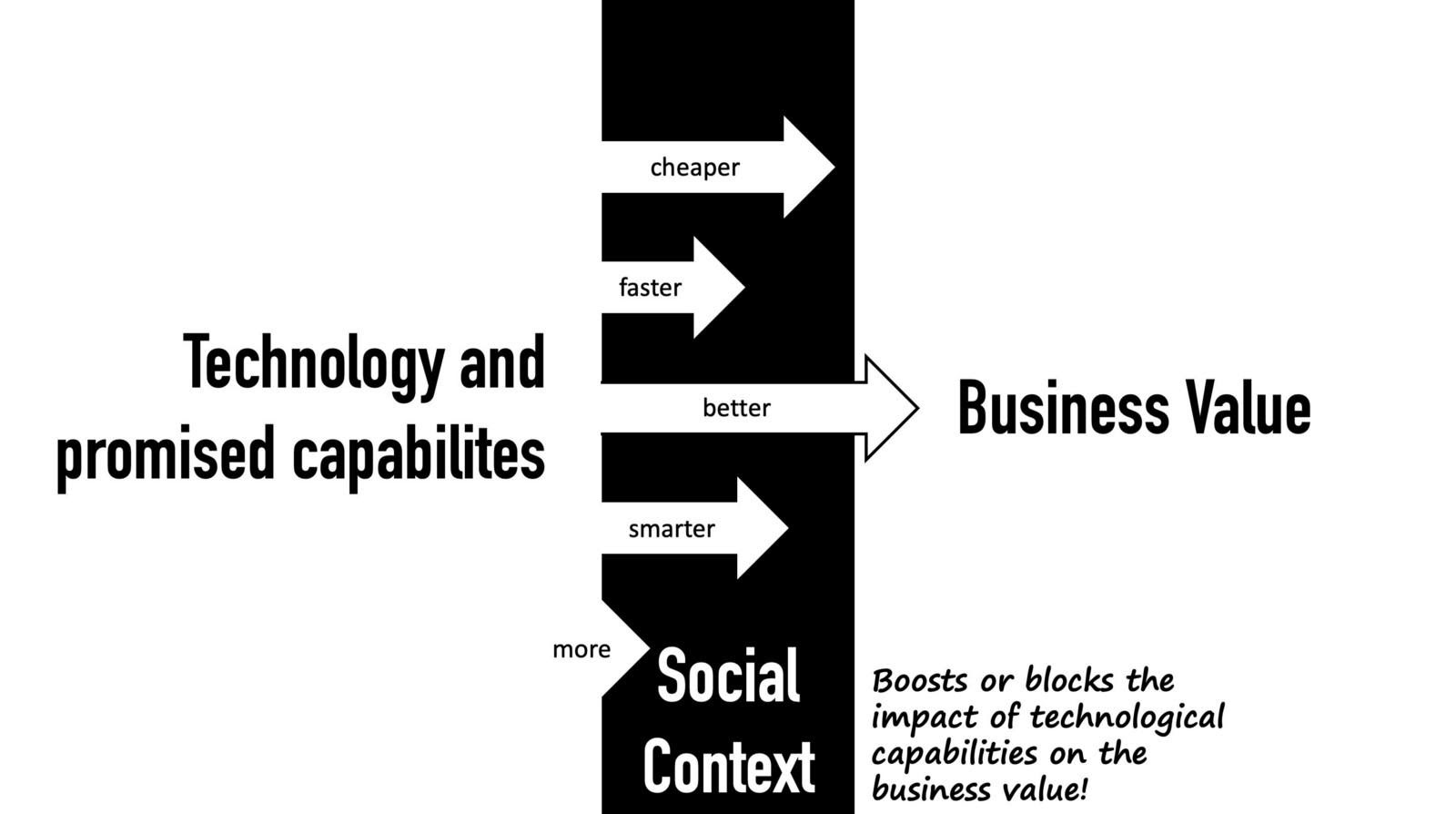In part 1, I presented how we digitalized and transformed the traditional assisted transport service of an NGO. The transformative change from digitalization to digital transformation is challenging because it requires change. The following image shows the three relevant stages.

Now in Part 2, I present the blockers and catalysts that make or break digital transformation. It’s based on my first-hand experience at the NGO and at many other organizations across industries (e.g., telecommunications, financial services, manufacturing, and healthcare). It helped me to assess an organization’s situation and conclude what actions to take.
Social context makes or breaks digital transformation
New technologies provide new capabilities and promise some benefits that create business value. At an NGO, we used API technology to create a new digital business model based on the API product Transport Care (see Part 1).
However, we haven’t succeeded yet due to lack of consideration for one aspect: the social context or organization. The social context blocks or boosts the impact of technological capabilities on creating business value.
The affordances model covers these three aspects and puts them into relation: technological capabilities, business value, and social context. I was inspired by my colleague, Marc Jost who identified the social context as a critical differentiator for when a platform-as-a-service product creates value.

Digital transformation is not another software project. It’s more than technology. Digital transformation is about making an organization ready to leverage the benefits promised by technological capabilities.
Blockers and catalysts of digital transformation
The social context consists of two types that make or break digital transformation: blockers and catalysts. Use them to assess your organization, identify your blockers and catalysts, and what actions to take.
Blockers of digital transformation
Blockers are elements that lower or even stop how technological capabilities affect business value. Eliminating blockers must be your priority.
- Doing APIs as projects: Many times, people build APIs as part of a project, however, projects are about execution. An API-as-a-project is good for digitalization, increasing efficiency, and saving money. However, projects lack adaptability in that learnings are not taken away, setting and adapting a vision, and creating and maintaining a roadmap. In other words, API-as-a-project is not good enough to create a digital business or build a digital ecosystem. Do API-as-a-product instead of API-as-a-project.
- No API strategy and no corporate strategy alignment: No strategy means no focus and no KPIs. If you don’t set a course and measure the progress, you don’t know if, how, and when to adapt the course. Further, if the API product doesn’t support the corporate strategy, then it won’t gain support from management. Develop your API strategy and align it with your IT and corporate strategy. Identify the opportunities and benefits of API inside and outside your organization.
- No accountability and no responsibility: Someone has to make decisions and being answerable for the actions, if the decision-maker doesn’t understand the product they will not make a decision. Make sure that the team who ideates, designs, and builds the API is accountable and responsible. It needs to be someone who cares and follows a vision. Get an API product manager who is accountable and a team of engineers who are responsible.
- Insufficient IT governance: Do you know how to bring an API product to production and who maintains it? There are vital roles and responsibilities, e.g., API product manager, API designer, engineers for development, security, and operations, etc. Make sure to define roles and responsibilities clearly. Distribute the roles to the right people; only someone who knows the customer’s needs and pains should design the API.
Catalysts for digital transformation
Catalysts boost the effect of technological capabilities on the business value. Establishing catalysts is your second priority to gain speed and maximum impact.
- Hire API product managers: The API product manager defines the why and what of that API product. It is this person’s job to research the market and identify opportunities, validate customer needs and pains, and get the digital product to full production. They understand how to navigate within an organization to make the next step happen based on new or existing corporate assets as well as stakeholder management. They connect customers, business, and technology.
- BizDevOps: Form API product teams that consist of business, development, and operations (i.e., API product manager, and DevOps engineers). This group communicates and collaborates on effectiveness, speed, and innovative outcomes.
- Get out of the building: Building products without talking with and understanding customers are destined to fail. Start talking to customers to understand their pains and jobs-to-get-done. Then, you’ll find problems worth solving.
- Do analytics-first: Calculating the number of API calls is useless, instead identify and monitor relevant KPIs. Relevant KPIs provide you insights on how to improve API products and organize the API ecosystem. Analytics provide you the data and insights, which support your decision making.
- Limit budgets: Yes, you read correctly! Too much budget creates comfort and allows for maintaining the status quo. When you limit resources, teams become value-driven and start innovating. It supports the meaning of accountability and responsibility. Allow them to participate in the value they create.
- Leverage the organization: Involve account managers and sales to help you getting customer attention. Provide both the materials to advertise API products with prospects successfully. They help to get customer feedback, especially from business partners.
Conclusion and recommendations
Digital technologies, like APIs, promise great business benefits. Digitalization is not a transformation; it’s a translation from an old approach to a new, digital approach.
Furthermore, I’ve demonstrated how API products enable new digital business models. However, the social context or organization sets limits on what technological benefits transform into business value.
Digital transformation is not yet another software project. Digital transformation is also not just about digital products. Digital transformation is about making an organization ready to leverage the benefits promised by technological capabilities.
Eliminate blockers to make technologies effective and create business value. For instance, stop thinking of API-as-a-project, align API products with corporate strategy, and make teams accountable and responsible for creating business value.
Establish catalysts to boost the effect of technological capabilities and benefits on the business value. For instance, hire API product managers, form BizDevOps teams who develop API products, and create a startup mindset among your teams. Then, organizations become genuinely digital and leverage the significant benefits promised by technology.
For more information on creating a digital transformation strategy with APIs, download our blueprint.









